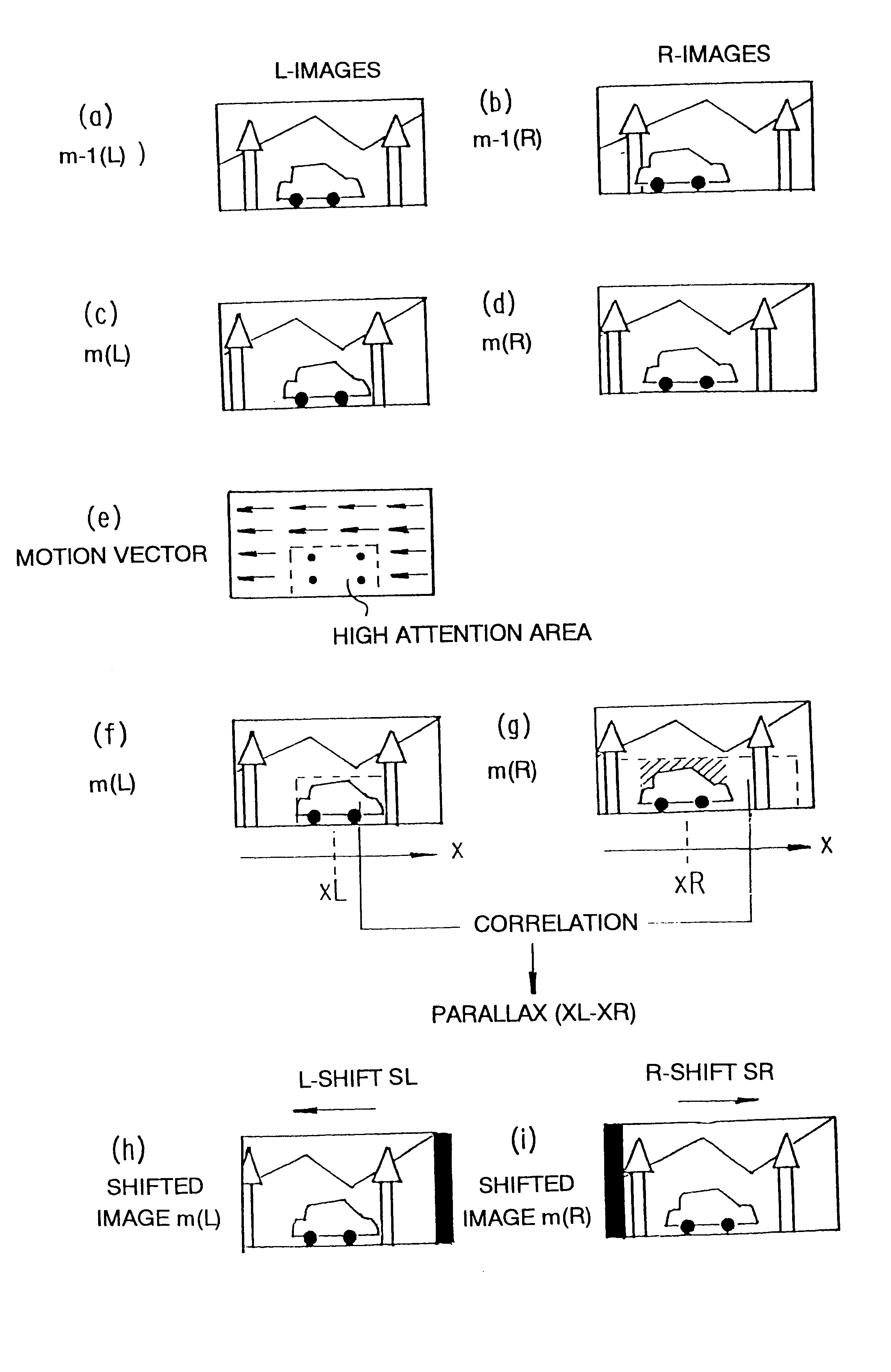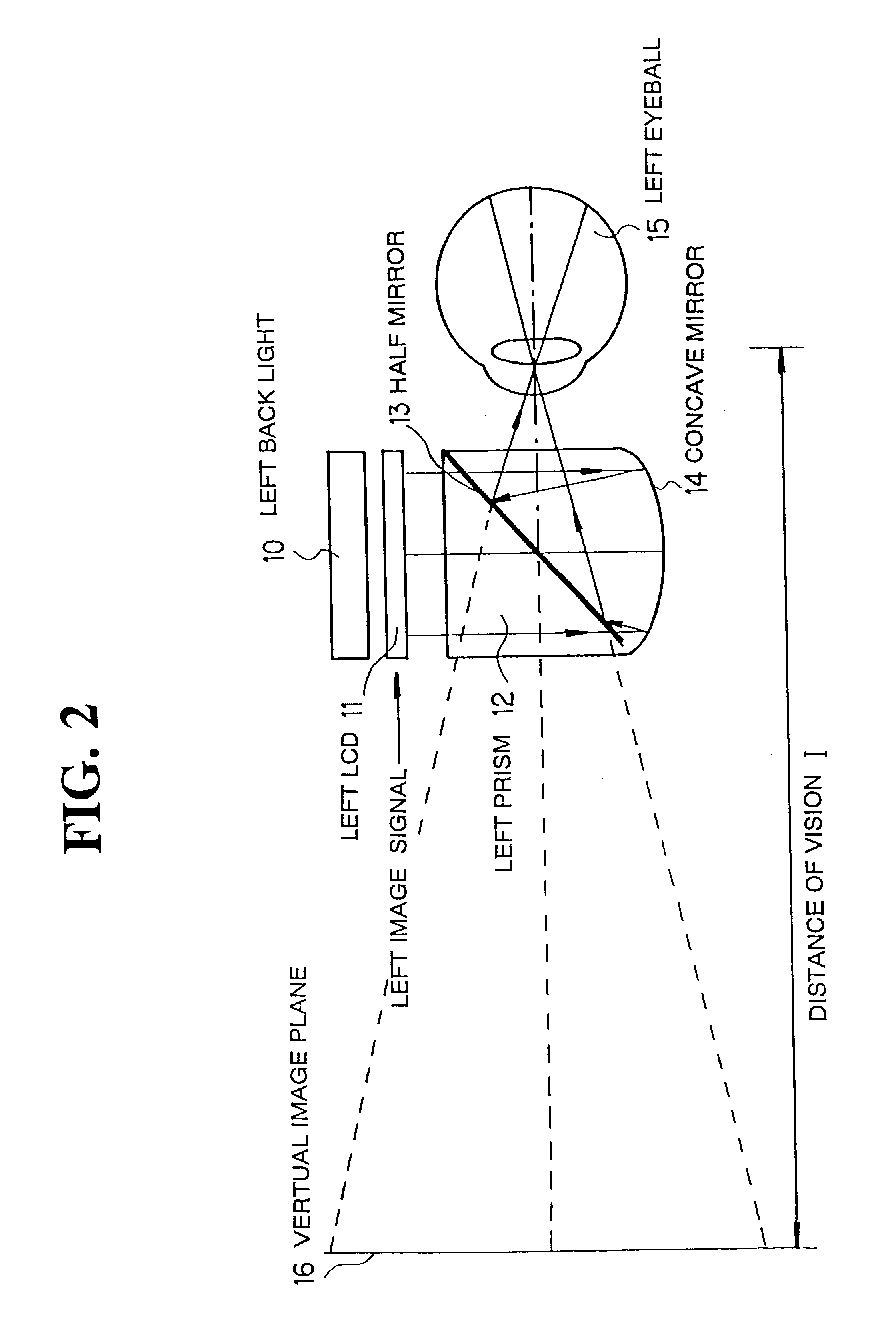Stereo image display unit
a display unit and image technology, applied in image enhancement, color signal processing circuits, instruments, etc., can solve the problems of high unit price, inconvenient use, and inability to adjust the focus,
- Summary
- Abstract
- Description
- Claims
- Application Information
AI Technical Summary
Problems solved by technology
Method used
Image
Examples
first embodiment
In the first embodiment, a local image area with a motion vector different from that of the remainder of the display surface is detected, depth (distance) of the image in the detected image area is obtained, and glance distance and vergence distance in a stereo image observation are controlled to be coincident with each other. In this embodiment, a left and a right image with a parallax between them are collectively referred to as a stereo image.
FIG. 1 is a view outlining the first embodiment of the stereo image display unit according to the present invention. The stereo image display unit illustrated in FIG. 1 comprises a stereo image generator 1, a stereo image processor 2 and a stereo image display 3. The stereo image generator 1 generates a stereo image signal SA (i.e., a left and a right image signals), and provides the signal together with a left and a right speech signal. The stereo image generator may be such an image generator as a video playback unit, a stereo image signal...
second embodiment
Now the present invention, which detects left and right image motion vectors, will be described.
In the first embodiment, motion vectors were obtained with only left or right images. The second embodiment is a modification of the first embodiment, and adapted to obtain motion vectors with both left and right images.
For example, as shown in FIGS. 15(a) to 15(j) with left images as shown in FIGS. 15(a) and 15(c) motion vectors as shown in FIG. 15(e) are obtained, and with right images as shown in FIGS. (b) and (d) motion vectors as shown in FIG. 15(f) are obtained. Then, respective high attention center presumable areas as shown in FIGS. 15(g) and 15(h) are determined.
Then, the center x coordinates xL and xR of the presumable attention center areas are obtained. The difference (xL-xR) between the x coordinates xL and xR is determined to be the parallax. Thus, in the second embodiment no correlation calculation is made.
FIG. 16 is a block diagram showing the internal construction of the ...
third embodiment
The third embodiment is also a modification of the first embodiment, and effective for field (or frame) sequential stereo image. Specifically, in this embodiment the parallax is obtained by detecting motion vectors between left and right images at different time instants and determining a parallax based on a high attention center presumability.
FIG. 17 is a flow chart illustrating the operation in the third embodiment. The operation will now be described in connection with an example of image processing shown in FIGS. 18(a) to 18(g). In this embodiment, left and right image frames are received alternately, such as right image frame m-1(R), left image frame m(L) and right image frame m+1(R) . . . as shown in FIGS. 18(a), 18(b) and 18(c).
(Step S11)
The left image frame m(L) is received.
(Step S12)
A motion vector m of the left image frame m(L) with respect to the right image frame m-1(R) for each block. That is, a motion vector is obtained by comparing adjacent image fields (i.e., compari...
PUM
 Login to View More
Login to View More Abstract
Description
Claims
Application Information
 Login to View More
Login to View More - R&D
- Intellectual Property
- Life Sciences
- Materials
- Tech Scout
- Unparalleled Data Quality
- Higher Quality Content
- 60% Fewer Hallucinations
Browse by: Latest US Patents, China's latest patents, Technical Efficacy Thesaurus, Application Domain, Technology Topic, Popular Technical Reports.
© 2025 PatSnap. All rights reserved.Legal|Privacy policy|Modern Slavery Act Transparency Statement|Sitemap|About US| Contact US: help@patsnap.com



